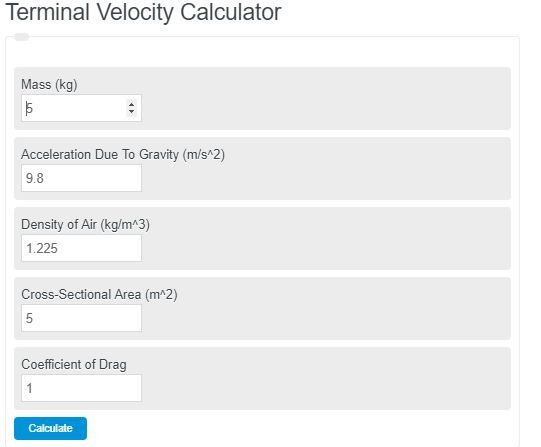Enter the mass, cross-sectional area, drag coefficient, density of air, and force due to gravity into the calculator. The calculator will evaluate the terminal velocity of that object.
- All Velocity Calculators
- Velocity Calculator
- Free Fall Calculator
- Free Fall Velocity Calculator
- Horizontal and Vertical Velocity Calculator
- Maximum Velocity Calculator
- Gravity To Velocity Calculator
Terminal Velocity Formula
The following equation is used to calculate the terminal velocity of an object.

- Where m is the mass of the object
- g is the acceleration due to gravity
- p is the density of the medium (air)
- A is the cross-sectional area
- Cd is the coefficient of drag
Terminal Velocity Definition
A terminal velocity is defined as the maximum speed of a falling object where the force of gravity and force of air resistance is equal.
Terminal Velocity Example
How to calculate terminal velocity
- First, measure the mass of the object
Measure the mass of the object in kilograms.
- Next, determine the acceleration due to gravity
On earth, this is approximately 9.8 m/s^2.
- Next, determine the density of air
Air has a density of 1.225 kg/m^3 at 1 atmosphere.
- Next, measure the cross sectional area
The cross-sectional area is the area that is exposed to the force of air resistance.
- Determine the coefficient of drag.
Using an experiment or theoretical data, determine an estimate for the coefficient of drag on the object.
FAQ
How does the cross-sectional area of an object affect its terminal velocity?
The cross-sectional area of an object directly influences its terminal velocity. A larger cross-sectional area increases the air resistance or drag force on the object, potentially reducing its terminal velocity. Conversely, a smaller area decreases air resistance, allowing for a higher terminal velocity under the same conditions.
Why is the coefficient of drag important in determining terminal velocity?
The coefficient of drag is a crucial factor because it quantifies how easily an object can move through a fluid, such as air. A higher coefficient indicates more drag, slowing the object down and lowering its terminal velocity. Understanding the coefficient of drag allows for more accurate predictions of an object’s terminal velocity.
Can terminal velocity change if the density of the medium changes?
Yes, the terminal velocity of an object can change with the density of the medium it is falling through. For example, an object will reach a lower terminal velocity in a denser medium like water compared to air because the increased density results in higher buoyant and drag forces acting against gravity.
